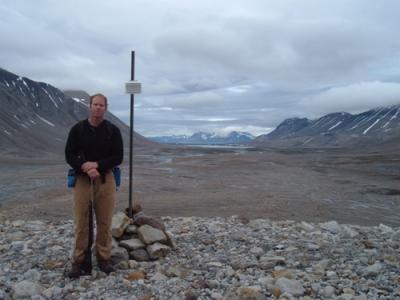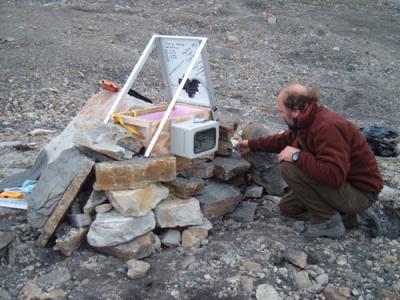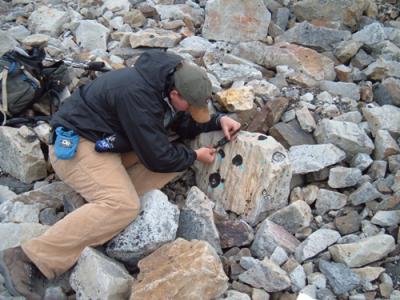
Tuesday,July, 24, Steve Roof and I hiked up the valley (in this case "up" is south) to service the "Galcier Cam" and check on the lichen stations. The hike was moderatly up hill over fine rock river plaine, large coarse rocks and then finally over moraines left by the glacier. The pace was brisk and the weather was overcast but comfortable at about 4 degrees celcius (39 F). I asked lots of questions to steve as we hiked and he patiently explained details like mass balance (the relationship between glacier formation and glacier degredation) and the multitude of environmental/climatic factors that influnce it. Steve also taught me about the formation of the moraines we were climbing over and I learned that the first moraine we reached was most likely an "ice core moraine" which, as the decription suggests consits of an ice interior in and around the rocks much like an ice aquifer. This particulary moraine has been dubbed by Al, Mike and Steve as the "little ice age moraine" because it was the most forward, advanced position of Linnebreen in the last 9-10K years. The moraine is a huge pile of rock bulldozed by the glacier down slope into the valley. In the picture, I am standing on the top of it next to a weather station set up by the team.

We reached the glacier cam and swithched out cameras, readjusted wires, rebolted the box and reset the camera position. We raised it up a bit on rocks to get a better picture, and as you can see by the photo we really got into it a bit. Lots of stone! That's OK because it has to make it through the entire winter without being oushed around. Hopefully it will hold.
We then hiked a short trip to the lichen stations. these stations are the olderst contiual lichen resarch stations, first established by Al as a grad student in the 80's. The idea is to monitor and measure the growth of these long living organisms to get an idea of when the glacier exsited at the point of the lichen area. Lichens colonize newly exposed rock after a primary successional event, such as a glacier retreating and leaving scoured rock. To age the lichens, measure there growth the team may be able to use it as a proxy record for glacial retreat. As always, it will be comapred and measured against other measuremts inthe sediment and tempeature records. I really enjoyed this partof the job because it melded biology and geology together. The picture is of me using digital calipers to measure established lichen samples that have been recorded for years.

After this Steve and I hiked back to the lake, hitched a ride to the other end of the lake and then hiked back to base camp and returned about 9 pm. and 18 mile day over rugged terraine. I loved every stop of it! I arrived at base camp, weary, sunburned (even in diffuse light the UV radiation is high), but content at the end of another wonderful day at 78 north latitude.


Comments